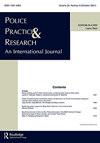The management of police specialized tactical units (3rd ed)
IF 1.8
Q2 CRIMINOLOGY & PENOLOGY
引用次数: 0
Abstract
The use of tactical teams has become one of the most contentious issues within policing. Often claimed as the embodiment of police militarization, their increased use has been suggested to expose the public to significant harm (Kraska, 2021). Notwithstanding the controversial nature of tactical teams, relatively little is known about how they are used and the implications of their use. Despite being framed as a police reference book, The Management of Police Specialized Tactical Units is valuable to anyone interested in developing a better understanding of the training, tactics, equipment, and legal implications associated with tactical teams. As an example, according to Mijares and McCarthy the purpose of tactical teams is not only to provide an improved response to high-risk incidents, but also to supply additional resources that maximize an agency’s capabilities to respond to other calls during an ongoing event. To Mijares and McCarthy, tactical officers reduce the likelihood and severity of force through a coordinated response underpinned by specialized training, tactics, and equipment. This is particularly true when contrasted with an ad hoc response by patrol officers who are not as familiar with each other, receive less training, and have access to less equipment (e.g., less-lethal systems, ballistic shields). Throughout the book the authors provide a comprehensive overview of the various mechanisms in place to maximize the likelihood of a successful outcome when tactical teams are used. For example, the authors note that tactical training should be founded in a concrete understanding of operational realities. Furthermore, the authors emphasize the importance of continuously evaluating personnel, teamwork, tactics, and equipment both in training and following a deployment to ensure that the team’s performance continuously improves. Arguably one of the most valuable components of the book is the authors’ analysis of case studies to discuss the legal implications regarding the use of tactical resources within the American context. Drawing on extensive knowledge from police and legal practitioners, the authors provide a clear and concise discussion of the legal parameters and organizational liability regarding the development, training, and use of tactical teams – something that has been notably absent from most discussions. The considerations provided by Mijares and McCarthy illustrate how, despite common criticisms of tactical teams conducting warrants, the use of patrol officers to carry out this task may be inadequate. Given that training related to clearing structures in a safe and effective manner is primarily restricted to tactical personnel, the use of inadequately prepared officers may result in serious harm, loss of life, and/or organizational liability. Therefore, the authors suggest that it is prudent to use tactical officers during warrant executions given their additional training and equipment, and the level of familiarization that they have with each other and their roles. Despite this, the authors do not adequately explain why the use of tactical resources for warrants has raised significant concerns. While Mijares and McCarthy effectively highlight how tactical practices, policies, and procedures have been refined through the culmination of collective experience, the authors miss numerous opportunities to discuss salient issues related to policing and the use of tactical teams. For example, the authors briefly acknowledge academics critical of tactical teams, such as Dr. Peter警察特种战术部队的管理(第三版)
战术小组的使用已经成为警务界最具争议的问题之一。经常被认为是警察军事化的体现,它们的增加使用被认为会使公众受到重大伤害(Kraska, 2021)。尽管战术团队的本质存在争议,但人们对如何使用战术团队以及使用战术团队的影响知之甚少。尽管作为一本警察参考书,《警察特种战术部队管理》对于任何有兴趣更好地理解与战术小组相关的训练、战术、装备和法律含义的人来说都是有价值的。例如,根据Mijares和McCarthy的说法,战术团队的目的不仅是提供对高风险事件的改进响应,而且还要提供额外的资源,以最大限度地提高机构在正在进行的事件中响应其他呼叫的能力。在Mijares和McCarthy看来,战术军官通过专门的训练、战术和装备,通过协调一致的反应来减少暴力的可能性和严重性。与巡逻人员的临时反应相比,这一点尤其正确,巡逻人员彼此不熟悉,接受的培训较少,使用的设备较少(例如,杀伤力较小的系统,弹道盾牌)。在整本书中,作者提供了各种机制的全面概述,以便在使用战术团队时最大化成功结果的可能性。例如,作者指出,战术训练应该建立在对作战现实的具体理解之上。此外,作者强调了在训练中和部署后持续评估人员、团队合作、战术和设备的重要性,以确保团队的表现不断提高。可以说,本书最有价值的组成部分之一是作者对案例研究的分析,讨论了在美国背景下使用战术资源的法律含义。利用警察和法律从业人员的广泛知识,作者提供了关于战术团队的发展、培训和使用的法律参数和组织责任的清晰而简洁的讨论-这在大多数讨论中明显缺失。Mijares和McCarthy提供的考虑说明,尽管战术小组执行逮捕令受到普遍批评,但使用巡逻人员执行这项任务可能是不够的。鉴于以安全和有效的方式清理建筑物的培训主要限于战术人员,使用准备不足的官员可能会造成严重伤害、生命损失和/或组织责任。因此,作者建议,考虑到战术军官的额外训练和装备,以及他们彼此之间的熟悉程度和他们的角色,在执行逮捕证时使用战术军官是谨慎的。尽管如此,作者没有充分解释为什么对权证的战术资源的使用引起了重大关注。虽然Mijares和McCarthy有效地强调了战术实践、政策和程序是如何通过集体经验的高潮而得到完善的,但作者错过了许多讨论与警务和战术团队使用相关的突出问题的机会。例如,作者简要地承认了批评战术团队的学者,如彼得博士
本文章由计算机程序翻译,如有差异,请以英文原文为准。
求助全文
约1分钟内获得全文
求助全文
来源期刊

Police Practice and Research
CRIMINOLOGY & PENOLOGY-
CiteScore
4.10
自引率
5.60%
发文量
50
期刊介绍:
Police Practice and Research is a peer-reviewed journal that presents current and innovative police research as well as operational and administrative practices from around the world. Articles and reports are sought from practitioners, researchers and others interested in developments in policing, analysis of public order, and the state of safety as it affects the quality of life everywhere. Police Practice and Research seeks to bridge the gap in knowledge that exists regarding who the police are, what they do, and how they maintain order, administer laws, and serve their communities. Attention will also be focused on specific organizational information about the police in different countries or regions. There will be periodic special issues devoted to a particular country or continent.
 求助内容:
求助内容: 应助结果提醒方式:
应助结果提醒方式:


